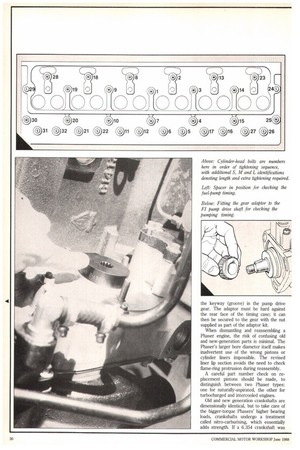Phase in updating
Page 125

Page 126

Page 127

If you've noticed an error in this article please click here to report it so we can fix it.
Fitters need not take a complete course to learn workshop procedure changes as the Perkins Phaser engine joins fleets — but take note of these points, advises Alan Bunting
IN Two years ago Perkins unveiled its new-generation middleweight truck diesels bearing the name Phaser, They are destined eventually to replace the familiar long-established four-cylinder 4.236 and six-cylinder 6.354 engines, Already Seddon-Atkinson has adopted the 160T and 180Ti in its 2-11 four-wheeler (now plated at 17 tonnes gross vehicle weight) where they are proving popular with users, particularly in the fuel economy department.
Renault-Dodge meanwhile has switched to the four-cylinder Phaser in its facelifted 50-Series vans and chassis-cabs; and we can expect the Commando, currently 6.354-powered, to "go Phaser" before too long.
By boring out the cylinders from 98.4 to just 100mm, Perkins has increased the swept volume of the Phasers to virtually one litre per cylinder, matching the capacity of the company's threatening new competitor on the scene — Cummins's B-Series, A number of innovations in the Phaser concept make for improved efficiency and productivity, not least the unique so-called Quadram bowl-in-head combustion chamber and computer-aided design changes which have brought a weight saving of about 25kg on the six-cylinder variants.
For those responsible for maintaining and servicing Phaser engines, Perkins is running workshop courses at Peterborough in an updated and relocated training school at the southern end of the main Eastfield site. As the company readily acknowledges, fleet operators' fitters already familiar with the later 4.236 and 6.354 engines should not need to undergo a complete course to learn the workshop procedure changes involved when Phasers go into service.
Valve timing methods are unaffected, but because the Phaser's (rotary) fuelinjection pump is mounted differently, in a horizontal position, directly driven from the back of the timing gear case, giving more flexibility for driving auxiliaries, the procedure for setting the pump timing is different.
A tapered drive with a keyway replaces the older, splined shaft, which means using a different timing adaptor, although the same timing tool used for 4.236/6.354 engines is employed.
The fuel injection pump drive-shaft gear comes in versions to suit the fourand six-cylinder Phaser variants and if it has to be replaced the correct identification on the gearwheel should be verified.
After removing the Bosch EPVE fuel injection pump, the key in the tapered shaft of the adaptor must be aligned with the keyway (groove) in the pump drive gear. The adaptor must be hard against the rear face of the timing case; it can then be secured to the gear with the nut supplied as part of the adaptor kit. When dismantling and reassembling a Phaser engine, the risk of confusing old and new-generation parts is minimal. The Phaser's larger bore diameter itself makes inadvertent use of the wrong pistons or cylinder liners impossible. The revised liner lip section avoids the need to check flame-ring protrusion during reassembly. A careful part number check on replacement pistons should be made, to distinguish between two Phaser types: one for naturally-aspirated, the other for turbocharged and intercooled engines. Old and new generation crankshafts are dimensionally identical, but to take care of the bigger-torque Phasers' higher bearing loads, crankshafts undergo a treatment called nitro-carburising, which essentially adds strength. If a 6.354 crankshaft was fitted in a 160T or 180Ti Phaser, durability would by implication be jeopardised.
When rebuilding a Phaser engine after internal attention, the cylinder head bolts are tightened "once and for all". Retorquing after 25 hours is no longer necessary, thanks in part to the use of new gasket materials and to the adoption throughout the Phaser engine of bolts each with a washer integrated into the hexagonal head, which helps achieve an even clamping load.
There are 22 hold-down bolts on the four-cylinder Phaser, and 32 on the "six". The tightening sequence is shown in Perkins' comprehensive workshop manual (publication TPL) 1087-1266). Following the sequence, all bolts are tightened to a torque setting of 110Nm.
Every one must then be further tightened by a prescribed angular movement, according to its length. (There are three lengths, readily apparent when looking along the head from one end). The shortest bolts must be turned — beyond the 110Nm tightened position — by 150 deg (21/2 hexagon fiats); the medium length bolts by 180 deg (3 flats); and the largest bolts, one at either end of the head, by 210 deg (31/2 flats).
Both the oil and water pump on Phasers are direct (gear) driven. If the oil pump has to be renewed or refitted, the idler gear below it and its bush should be checked for wear and damage. They can be renewed as an assembly or the bush alone can be replaced. Backlash (ie tooth clearance) between the idler gear and the oil pump gear above it and the crankshaft gear below it should not be less than 0.076mm.
To remove or refit the water pump, it is no longer necessary to touch the fan or to loosen any belts. When refitting the pump, the rubber 0-rings on the pump body should be checked for damage and renewed if necessary.
It is normal for the pump to be a tight fit in the timing case cover, but it can be pulled into position if the securing studs are gradually and evenly tightened, ensuring meanwhile that the 0-ring in the timing case cover groove remains in position.
Special tools are available from Perkins, or direct from V L Churchill, the manufacturer, to handle Phaser engine servicing specifically. They include: • Timing gauge adaptor; • Fuel pump timing-mark checking fixture; • Timing-gauge spacer; • Water pump gear remover; • Fuel pump gear and camshaft; gear remover bolts; • Cylinder liner remover/replacer adaptors; • Piston replacer sleeve; • Valve spring compressor adaptor.
Perkins Turbo 71 V L Churchill Turbo 72




































































































































